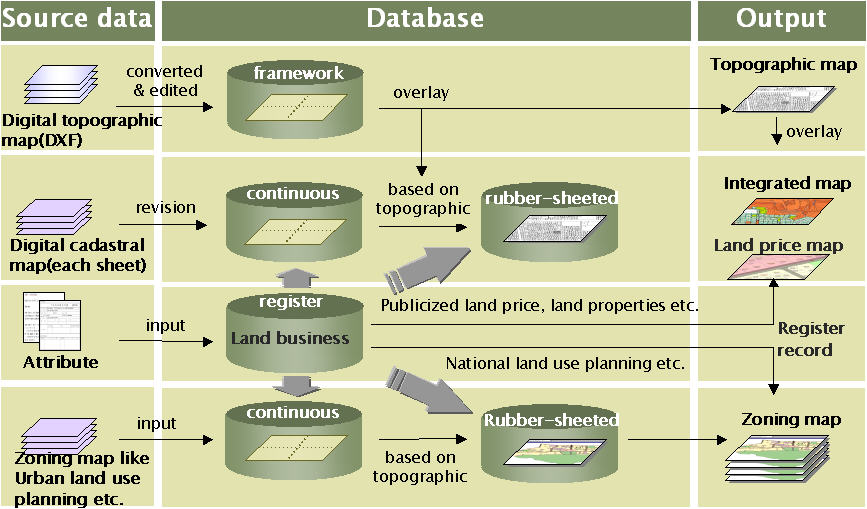
Byong-nam Choe, Jong-yeol Lee, Dae-jong Kim, Mi-jeong Kim, Kwon-hwan Lee, Chang-wan Seo
Abstract: This presentation will provide the overview of the Land Management Information Systems (LMIS) Development Project that is undergoing in Korea. This project aims to cover land use planning, land management policy, land administration systems. Specifically, it includes the stategy of land management, public/private partnership development, descriptions for the system architecture, database, and applications developed, and the future directions of the project. The LMIS developed will be also demonstrated, which consists of land mangement system, spatial planning support system, and land policy support system.
Local and central government(MOCT; Ministry of Construction and Transportation) have many land management businesses. Services for public and businesses for basic data creation and maintenance are mainly carried out by local governments. MOCT collects and analyses the data related to land, and develops various land policy based on them. But it is very difficult to make rational and scientifical land policy in timely manner because the data are collected through many steps in conventional-manual method.
More over, there are many zoning systems to manage land use based on laws in this country. It is not easy to search what regulations designated on a land parcel. Inconsistency of regulations between zoning systems is often happened. Inconsistency also takes place because zoning systems designate their own maps used, which have different scales and are different types one another. However these not exposed seriousely in analogue format of data such as paper maps. These cause some difficulties in data sharing in digital format.
To solve these problems, some local governments had introduced information technologies including GIS. Because these efforts has been accomplished in local scope without nation-wide consideration, many problems is happening in data sharing and interoperabilty.
The Land Management Information Systems(LMIS) Development Project had launched in 1998 by central government to solve the problems and to improve land management business process using GIS.
LMIS aims to develop diverse application systems to improve administrative land management businesses. Those are as follow;
Local government's land management business
Currently, in Korea, there are 16 provincial-level governments, and 232 lower-level local governments (municipal governments), including 72 si (city) governments, 91 gun (county) governments, and 69 gu (city district) governments within the autonomous cities.
Central government(Land Bureau of MOCT)'s land policy business
Business process between local and central gov't
Supervision(main sponsor)
Executing Agencies
Central gov't
Local gov't
1997. 5 Feasibility study on LMIS
1997.7 Master plan
1998.2 - 1998.12 Pilot project(for a local gov't)
1999.9 - 2000.12 1st stage(for 12 local gov't)
2000.8 - 2001. 6 2nd stage(for 60 local gov't)
BPR(business process reengineering) is needed. Land management business process must be properly changed to new information technology environment. Land management business, which defined in a related acts and ordinances will be processed by online networking. Many steps that are necessary in conventional business process could be eliminated through data sharing and networking. There might be many institutional factors to be improved for this BPR. A study on the improvement of land management related laws and regulations is undergoing.
The LMIS development project was initiated to share land information data through nationwide network for public service and policy making by central government(MOCT). For this, integrated data model and contents standards were established and now are being maintained every year.
Local governments have very diverse computer platform some another. They also have various GIS S/W's. An open system architecture could provide interoperability between different computer platforms and different S/W's. It will make local governments share existing resouces in this computing environment. LMIS has adapted 3-tier open system architecture for interoperability in this computing environment, which is compose of client, DB Server and middleware. This architecture enables also nationwide data sharing and scaling up.
LMIS has been developed for six land management businesses. Each business application has similar functions as like map display, print, zoom in or out etc. In object-oriented programming and distributed object technology, a component is a reusable program building block that can be combined with other components in the same or other computers in a distributed network to form an application. So it is an efficient way of decomposing business process into common meaningful unit. And these could be developed as components using CORBA or COM techonology. LMIS components are reused in a distribued computing environment.
LMIS will be the nationwide network system that connects local and central government's systems that have their own database and common application. For this, a distributed computing environment is needed.
One of the goals of LMIS is to manage land data from local governments in a real time, to serve zoning information to citizens at any time and any place to improve the efficiency of land management business. These will be accomplished by nationwide online networking.
The elements of LMIS consists of H/W, S/W, N/W, database, application, and public servants who operate this system. First of all human resources are the most important factor. The success of the project depends on actively participation of officials in charge in system developing stage, and using LMIS. Information mind of local government officials are not formed concretely yet. Education for information mind, project management methodology will be very helpful for local government's public servants. Also user operation for application have been educated after installation.
National GIS project was initiated in 1995 in Korea. As a part of that, digital topographic maps were made in a CAD format(DXF). This is composed of about 670 layers. But the data have limitations in analyzing and utilizing as GIS data. In LMIS project the data are converted to GIS data, several themes such as road, building, stream, geodetic point, elevation, railway, etc., are selected among them, and cleaned for this project.
Cadastral map is very important in Korea because people regard land as important property. That is to say that people have great concerns for their area of land, the the boundary of parcel must be accurate. But paper cadastral maps that were made in 1910's by Japan have been expanded and shrinked from their original status. Naturally there are many difficulties in edgematching. And the data do not have consistency exactly with topographic map because of the problems. To solve the problems, the project of computerizing cadastral map was implemented in 1999. In this project only existing cadastral maps are digitized as register maps. But LMIS needs continuous cadastral maps and edited map to overlay on topographic maps for land administration business data.
There are many zoning maps for land use regulation, such as national land use planning map, urban land use planning map, agriculture promotion zoning map, forest land use map. These data have legal relationships or spatial context. But the difficulties in data sharing between departments charge of the businesses and the lack of accuracy in manual business process makes inconsistencies on these data. These problems has been studied to build consistent zoning map database, and now a guideline for resolving then is laid out.
All above data have relationships each other and these are important in database building. Figure 1 shows the database building process and the relationships between them.
Figure 1. Database building process model

LMIS has four major systems, such as land management business system, spatial data management system in local gov't, land use planning support system in provincial gov't, and land policy-making support system in central gov't(MOCT). Land management business system has six application sub-systems.
Figure 2. Conceptual Diagram of LMIS
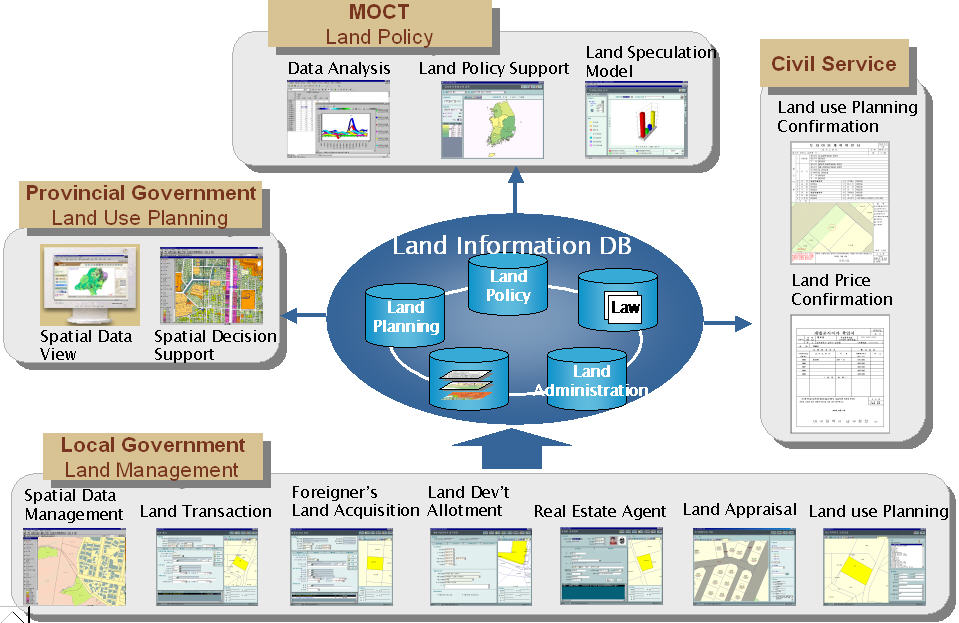
LMIS is developed with a 3-tier architecture regarding heterogenious computing environments in local gov'ts. In other words, open system architecture is necessarily adopted to share data and to service nationwide on various computer platform in local governments. Specially the middleware, which has functions as broker between DB Server and client, can make free from different computing environments.
Figure 3. System Architecture
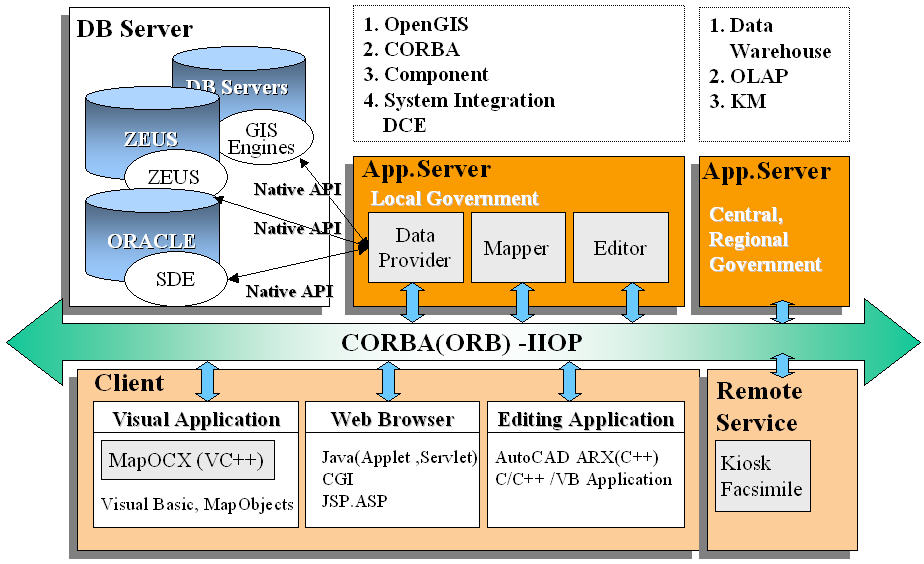
Local governments have various computing platforms. For sharing data and supporting nationwide through on-line network, middleware was considered as a solution under heterogeneous computing environments. This could be developed to support communications between diverse DB server and clients. The middleware makes any client independent from server platform, but necessarily to enable to be interoperable.
The LMIS middleware was based on OpenGIS CORBA sepcification for development of standard interface, RUP(rational unified process) for development method, UML(unified modeling language) for system design, VisiBroker, C++ and JAVA for system implementation. The components of open LMIS middleware are data providers that make any kind of server or S/W can access SDE and ZEUS as GIS server, MapAgent that displays maps, OpenView that has core functionalities of GIS, MapOCX that provides spatial information to client, and web service that provides citizens to zoning information through internet.
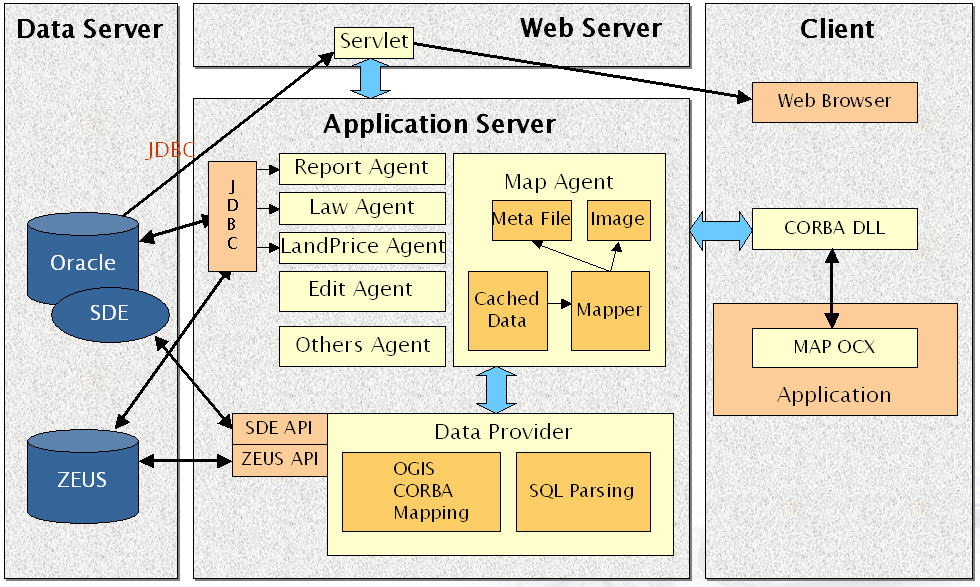
Land management business system of local gov't consist of seven applications, which are including one spatial data management system and six administrative management systems such as land transaction, foreigner's land acquisition, land development allotment, real estate agent, public land pricing, zoning system.
Figure 5. Public land pricing management system in local gov't
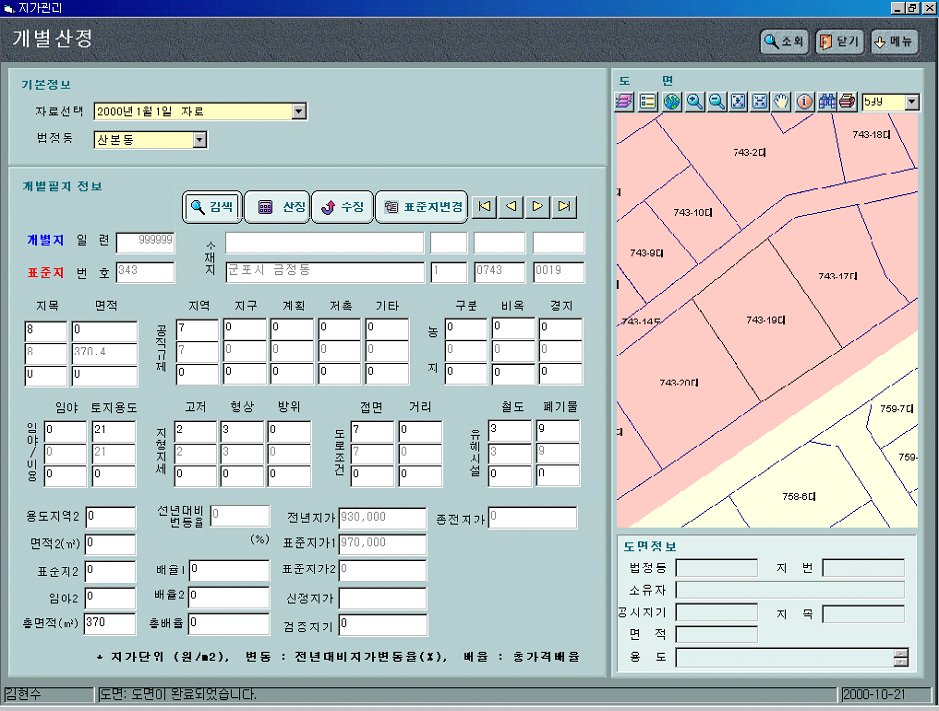
Land use planning support system for provincial gov't is developing as a web-based intranet system. Anyone who has a permission to access the system in provicial gov't can easily install web browser, connect LMIS DB Server and search and display data that he wants.
The central gov't(MOCT) needs to analyze land data collected from local governments. The land policy-making support system can make statistics, moniter land speculation, and support spatial decision making. The prototype system was developed with Arc/info S/W, Visual basic, C++ etc.
Figure 6. Land policy-making support system(prototype) of central gov't(MOCT)
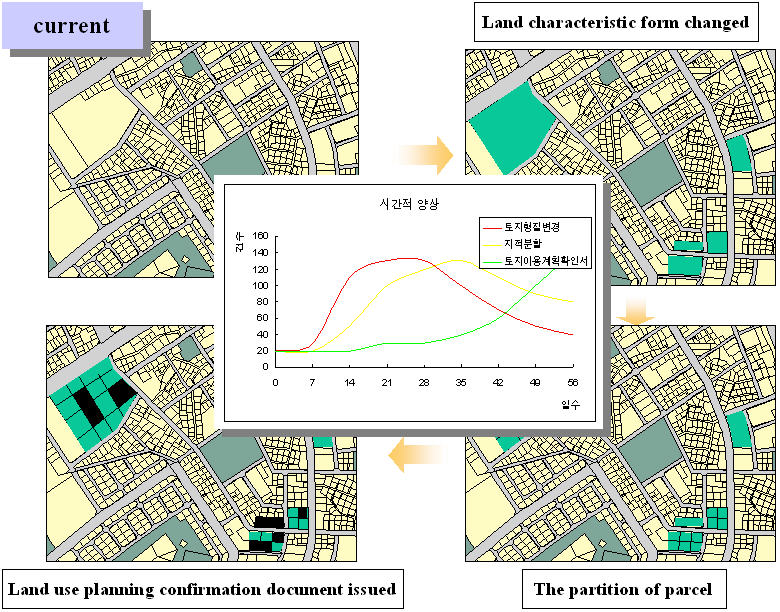
This LMIS development project will be done till 2004. Certainly the information technology will be developed.
G4C(Government for Citizen) project was launched in 2000 by the central governments in Korea. Its goal is to make small but strong government for data sharing inter-devisions using various information technology. A Law related to digital authentication, digital signing and encryption was alreay enacted. And from July 1st, new law related to electronic government will come into operation. As result of this project, civil affair documents that citizens should summit for their business with local governments will be simplified or minimized, and civil inquiries would be reduced.
LMIS project also could be understood in this context. This has to deal with various civil petition related to land use in electronic or cyber government. It requires many researches on new techology and institutional device for LMIS in electronic government.
There are personnel appointments frequently. This means that officials who manage LMIS can be changed suddenly. If the system does not have user-friendly interface, a newly recruited person should spend a lot of time to be accustomed to the system, or anyone might give up to use the system. Therefore sophisticated and user-friendly interface is necessary. A further research on UI with BPR shold be implemented.
The final goal of information system is to support decision-making, and LMIS is not an exception. Techniques analyze land data collected from local governments in real time have to be developed. Nowadays trends of current research for LMIS should move from database creation and maintenace and application development to land data analysing techniques.
Acknowledgements:
Tae-ho Kim, Land Bureau of MOCT, Chief of Land Management Division
Cha-hyun Back, Land Bureau of MOCT, Director of LMIS Project
Jae-jeong Heo, Land Bureau of MOCT, Assistant Director of LMIS Project
Eun-ho Mun, SK C&C, Director of LMIS Dev't Team
Kyu-soo Kim, SK C&C, Director of LMIS Data Base Dev't Team
Gi-seob Shin, SK C&C, Director of LMIS Installation & User Education Team
Web site: http://lmis.moct.go.kr
Authors information:
Byong-nam Choe, Research Fellow of KRIHS(Korea Research Institute for Human Settlements), Director of LMIS Research Team
Jong-yeol Lee, Research Fellow of KRIHS, Co-director of LMIS Research Team
Dae-jong Kim, Associate Research Fellow of KRIHS, Assistant Director of LMIS Research Team
Mi-jeong Kim and Kwon-hwan Lee, Researcher of KRIHS
Chang-wan Seo, SK C&C, Director of LMIS Application Dev't Team